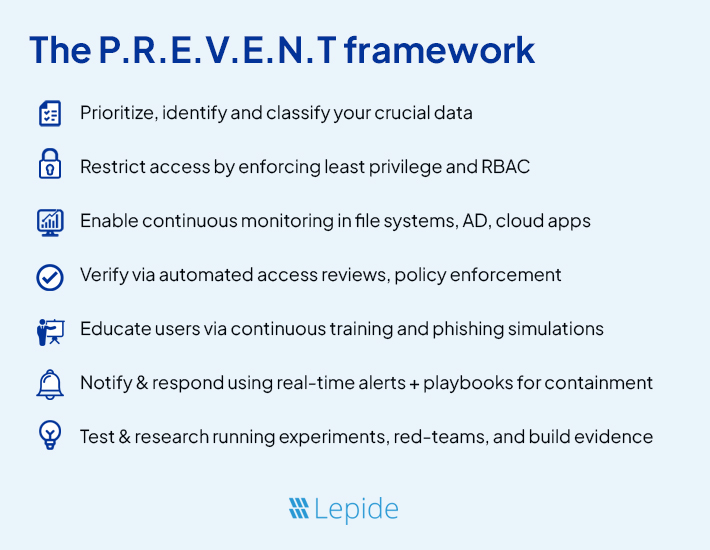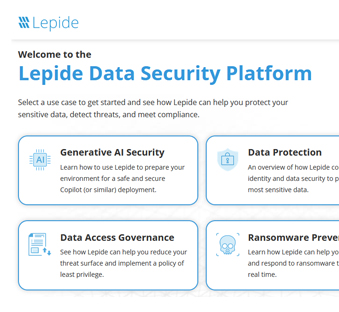
Insider threats, which can be malicious, negligent, or compromised, pose a unique risk as they are brought about by trusted accounts that have legitimate access. To prevent them, it takes prevention-first thinking and not investigation after an event.
This article provides a structured, enterprise-grade playbook to prevent insider data breaches, including a repeatable framework, detection and response playbooks, metrics to prove impact, a rollout roadmap, and suggested original research assets that leadership, GRC, and security operations teams can use to justify investment.
What Are Insider Threats and Why Do They Matter?
Insider threats refer to risks posed by individuals who have legitimate access to systems, data, or networks. These insiders may act maliciously, such as stealing intellectual property or selling confidential data to competitors. They may act negligently, such as misconfiguring a database, falling for phishing attacks, or sharing sensitive information carelessly. And in some cases, they are compromised, where attackers hijack legitimate accounts through stolen credentials.
In contrast to external threats, insider threats bypass the conventional security mechanisms since the action is initiated by the trusted accounts. This can be considered legitimate traffic to a firewall or intrusion detection system, although it could be harmful. It is precisely because insider-associated data breaches are always rated among the most expensive in the industry. Besides the direct financial effect, they may result in reputational damage, provoke regulatory fines, and the irrecoverable loss of intellectual property.
The Real Costs of Insider Threat Data Breaches
Dealing with insider threats is a survival issue rather than a choice. Based on existing research in the industry, insider cases may take significantly longer to resolve than outside attacks, typically spanning several months. Sensitive data may be revealed, stolen or sold during the course of time and increasing the harm. The risks include:
- Regulatory fines: Failure to comply with frameworks such as PCI DSS, HIPAA, or GDPR may lead to serious fines and lawsuits.
- Reputation damage: Customer confidence is easy to lose and one insider breach can destroy years of goodwill.
- Operational downtime: Investigations usually involve taking systems offline, which interferes with the business operation.
- Loss of intellectual property: Intellectual property, such as trade secrets, research, and proprietary information, is the most common victim of insiders with malicious intent, and once stolen, it is never recovered.
The neglect of insider threats does more than expose the business model to risk; it puts it in danger of total collapse.
6 Proven Strategies to Prevent Insider Threat Data Breaches

1. Enforce the Principle of Least Privilege
The principle of least privilege is one of the best methods of restricting insider risk. The information and systems that only people need to execute their role should be made available to the user. This reduces the harm that could have occurred in case an account is abused. Performing frequent access audits will make sure that obsolete or unneeded permissions are eliminated in time. Use of role-based access control (RBAC) also assists in having permissions in relation to particular job functions, thereby minimizing the chances of privilege creep with time.
2. Audit User and Entity Behavior
Insider attacks usually have some footprint left behind prior to the time of actual exfiltration. To give an example, a user may abruptly download a huge amount of files, connect with strange points or even strive to access what is beyond his or her position. Such actions might appear to be harmless individually, but when observed together, they will be very suspicious. That is where User and Entity Behavior Analytics (UEBA) comes in handy. Setting the foundations of normal activity and identifying anomalies enables early detection by UEBA, which allows security teams with opportunity to act early, before a breach becomes more severe.
3. Automate Data Classification and Access Reviews
Companies cannot secure what is not visible. The basis of insider threat prevention is in data classification since it makes sure that important data is properly labeled and secured based on its value and risk. Automated classification tools allow tagging files as soon as they are created or amended so that no sensitive document is left undetected. This should be coupled with automated access reviews so that sensitive data will not be accessed by the wrong people, and the gaps that insiders may determine are closed.
4. Provide Continuous Security Training
Human error is still among the most common reasons for insider-based breaches. The employees can make the first line of defense, however, only when they are aware of what to monitor. The security training must be a continuous and interactive process during which employees are educated to identify a phishing attack, manage sensitive information, and act in accordance with the law. Training, which has been conducted annually, is no longer sufficient; modern training should be continuous, adaptive as well, and based on various positions within the organization.
5. Implement Data Loss Prevention (DLP) Tools
Data Loss Prevention systems are used as a security measure against unauthorized data sharing or exfiltration. They can block or notify the administrators in case the users have tried to mail sensitive files to their own emails, duplicate them on the USB drive, or transfer them to unauthorized cloud services. It is also possible to track content with modern DLP solutions as structured data, including credit card numbers, or unstructured data, including intellectual property, will not slip out of the organization without anyone noticing it.
6. Reinforce Offboarding and Third-Party Processes
It is important to revoke credentials as soon as employees leave the organization or as third-party vendors no longer require access. The longer the offboarding procedure takes to complete, the more likely it is an opportunity for insider misuse of credentials. A well-governed offboarding program provides assurance that accounts are disabled in a timely manner, credentials are revoked, and vendor access is reviewed on a regular basis, thus reducing the insider risk and enhancing compliance posture.
How Lepide Helps Prevent Insider Threat Data Breaches
To stop insider threats, policy alone is not enough; organizations also need the technology to enforce the policies. The Lepide Data Security Platform has been engineered specifically to give organizations visibility, control, and proactive detection. The following is a list of things you can do with Lepide. You can:
- Use User and Entity Behavior Analytics (UEBA) to detect anomalous file activity, privilege escalation, or anomalous login behavior.
- Automate access reviews to identify over-permissioned accounts fast, and enforce least privilege.
- Utilize data classification to locate and protect against sensitive information across file systems and cloud environments.
- Get real-time alerts with contextual reporting so you can identify risky behavior faster and meet compliance requirements.
By incorporating monitoring, automation, and classification, Lepide enables organizations to mitigate insider-driven breaches before they cause undue damage.
FAQs
1. What is the most effective approach for preventing data breaches as a result of insider threats?
The most effective way is to take a layered approach: enforce least privilege access controls, monitor user activities, properly classify sensitive data, provide ongoing end-user training, and have DLP solutions in place. Applications such as Lepide are useful in helping companies implement these types of actions at scale.
2. Why are insider threats less likely to be identified than threats from external attacks?
Insider threats originate from a legitimate account that has been granted approved access to a resource. Their actions generally appear “normal” on the surface and are therefore difficult to determine if malicious in nature using traditional security tools, such as firewalls or intrusion detection software.
3. How does employee training help lessen breaches related to insider threats?
Training is critical in alleviating human error, which is one of the most common reasons for an insider breach. Employees adequately trained to detect phishing attempts, respond appropriately to sensitive or classified data, and overall follow security best practices will be less likely to unintentionally cause a breach.
4. What solutions assist organizations in reducing the risk of insider data breaches?
Solutions are Data Loss Prevention (DLP) software, User and Entity Behavior Analytics (UEBA), data classification solutions, and automatic access reviews. Lepide’s Data Security Platform combines all of those capabilities into one platform.
How does Lepide defend against an insider threat?
Lepide Data Security Platform offers complete visibility into user behavior, automated lease privilege enforcement, classifies sensitive data, and provides real-time alerts. Together, all of these capabilities allow an organization to prevent insider threats prior to them developing into full breaches.
If you want to know more about how Lepide can help you in mitigating the risks associated with insider threats, schedule a demo with one of our engineers or Download for the free trial today!



